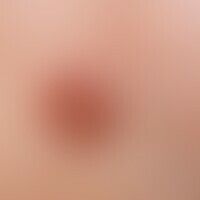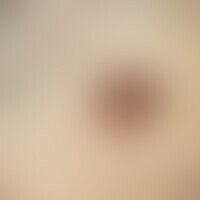Image diagnoses for "Nodules (<1cm)", "Face", "brown"
29 results with 41 images
Results forNodules (<1cm)Facebrown

Demodex folliculitis B88.0
Demodex folliculitis: detailed section with follicular, inflammatory papules.

Dennie morgan infraorbital fold L20.8

Nevus melanocytic papillomatous D22.L

Acne (overview) L70.0
Acne papulo-pustulosa: severe (untreated) clinical picture with inflammatory papules, papulo-pustules and pustules in a 16-year-old patient. picture of acne vulgaris (type: acne papulo-pustulosa, grade IV). classic indication for systemic isotretinoin therapy!

Verruca vulgaris B07
Verrucae vulgares: solitary, flat and stalked papules and plaques, also aggregated to beds, with fissured, hyperkeratotic-verrucous surface; secondary findings include lipodystrophy in HIV infection.

Contagious mollusc B08.1
Molluscum contagiosum: multiple mollusca contagiosa in the face of an Ethiopian boy.

Basal cell carcinoma nodular C44.L
Basal cell carcinoma, nodular, sharply defined, shiny, smooth tumor interspersed with bizarre "tumor vessels", which are particularly prominent in this nodular basal cell carcinoma and play an important role in the diagnosis.

Acne papulopustulosa L70.9
Acne papulopustulosa: in acne-typical distribution, brown papules and papulo-pustules in different stages of development.

Old world cutaneous leishmaniasis B55.1

Acne conglobata L70.1
Acne conglobata: in acne-typical distribution, brown papules, nodules, papulo-pustules, aggregated in places, distinct seborrhoea.

Early syphilis A51.-
Syphiis: papular syphilide, acne-like clinical picture with disseminated, non-itching, occasionally eroded, scaly papules.

Basal cell carcinoma pigmented C44.L
Basal cell carcinoma pigmented: A slow-growing, sharply defined, surface-smooth, sometimes shiny, brown lump with smaller crusts and scaly deposits that has existed for years.

Demodex folliculitis B88.0
Demodex folliculitis 20-year-old female patient without previous acne vulgaris, slight tendency to rosacea erythematosa. histological: massive infestation of the follicles with Demodex folliculorum.

Fibroma molle (skin tags) D23.-
Fibroma molle: a harmless, symptomless "tumour" which has been known for many years and has remained unchanged without any symptoms; the presence of a completely fibromatically transformed dermal melanocytic nevus cannot be excluded.

Demodex folliculitis B88.0
Demodex folliculitis: follicular inflammatory nodules. Infection of the eyelids.

Acne (overview) L70.0
Acne papulopustulosa: disseminated follicular papules, pustules and comedones; mild form of acne in an Ethiopian patient.

Facial granuloma L92.2
Granuloma eosinophilicum faciei: Very discreet, symptom-free, flat plaque that has existed at this site for 0.5 years. 42 years of otherwise healthy male.

Leprosy lepromatosa A30.50
Leprosy lepromatosa: advanced findings with numerous, almost symmetrically distributed, asymptomatic papules and nodules, no accompanying inflammatory reaction.






